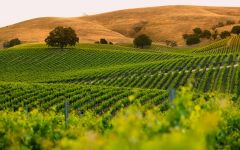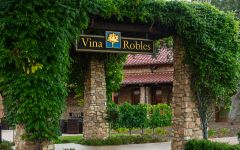Vina Robles The Arborist 2019
-
Wine
Enthusiast



Product Details
Your Rating
Somm Note
Winemaker Notes
The 2019 Vina Robles The Arborist is a dark garnet color. The nose displays notes of dark cherries and plum with hints of chocolate, spice, and fine tobacco. Medium body palate with dark stone fruits, fleshy textured tannins into the finish.
Blend: 45% Syrah, 40% Petite Sirah, 10% Grenache, 5% Tannat
Professional Ratings
-
Wine Enthusiast
This fairly priced twist-top blend of 45% Syrah, 40% Petite Sirah, 10% Grenache and 5% Tannat is a complex yet easygoing bottling. Dark plum, iodine, charred beef and violet aromas drop into a hearty, rich palate of blackberry jam and smoked meat, with delicate garden herb elements on the finish.
Other Vintages
2021-
Wine
Enthusiast -
James
Suckling
-
Wine
Enthusiast
-
Wine
Enthusiast







Growers and makers of expressive, approachable estate wines from Paso Robles, California, Vina Robles owns and farms six estate SIP® Certified Sustainable vineyards in five sub-districts in the region. First class hospitality service is offered by way of unique, memorable experiences with wine, food and music at their core. The vineyards & winery are owned and managed by two Swiss families who have been farming winegrapes in Paso Robles for more than 20 years
Known primarily for their Cabernet Sauvignon and Petite Sirah, the Vina Robles lineup includes small lots of a wide range of varieties and creative blends. While adhering to traditional winemaking methods, veteran winemaker Kevin Willenborg implements modern technologies to make his estate wines with minimal intervention.

With hundreds of red grape varieties to choose from, winemakers have the freedom to create a virtually endless assortment of blended red wines. In many European regions, strict laws are in place determining the set of varieties that may be used, but in the New World, experimentation is permitted and encouraged resulting in a wide variety of red wine styles. Blending can be utilized to enhance balance or create complexity, lending different layers of flavors and aromas. For example, a red wine blend variety that creates a fruity and full-bodied wine would do well combined with one that is naturally high in acidity and tannins. Sometimes small amounts of a particular variety are added to boost color or aromatics. Blending can take place before or after fermentation, with the latter, more popular option giving more control to the winemaker over the final qualities of the wine.
How to Serve Red Wine
A common piece of advice is to serve red wine at “room temperature,” but this suggestion is imprecise. After all, room temperature in January is likely to be quite different than in August, even considering the possible effect of central heating and air conditioning systems. The proper temperature to aim for is 55° F to 60° F for lighter-bodied reds and 60° F to 65° F for fuller-bodied wines.
How Long Does Red Wine Last?
Once opened and re-corked, a bottle stored in a cool, dark environment (like your fridge) will stay fresh and nicely drinkable for a day or two. There are products available that can extend that period by a couple of days. As for unopened bottles, optimal storage means keeping them on their sides in a moderately humid environment at about 57° F. Red wines stored in this manner will stay good – and possibly improve – for anywhere from one year to multiple decades. Assessing how long to hold on to a bottle is a complicated science. If you are planning long-term storage of your reds, seek the advice of a wine professional.

Paso Robles has made a name for itself as a source of supple, powerful, fruit-driven Central Coast wines. But with eleven smaller sub-AVAs, there is actually quite a bit of diversity to be found in this inland portion of California’s Central Coast.
Just east over the Santa Lucia Mountains from the chilly Pacific Ocean, lie the coolest in the region: Adelaida, Templeton Gap and (Paso Robles) Willow Creek Districts, as well as York Mountain AVA and Santa Margarita Ranch. These all experience more ocean fog, wind and precipitation compared to the rest of the Paso sub-appellations. The San Miguel, (Paso Robles) Estrella, (Paso Robles) Geneso, (Paso Robles) Highlands, El Pomar and Creston Districts, along with San Juan Creek, are the hotter, more western appellations of the greater Paso Robles AVA.
This is mostly red wine country, with Cabernet Sauvignon and Zinfandel standing out as the star performers. Other popular varieties include Merlot, Petite Sirah, Petit Verdot, Syrah, Grenache and Rhône blends, both red and white. There is a fairly uniform tendency here towards wines that are unapologetically bold and opulently fruit-driven, albeit with a surprising amount of acidity thanks to the region’s chilly nighttime temperatures.
